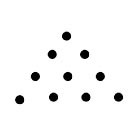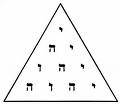
Tetraktys (Tetractys) of the Decad, The Monadic Values: There is no doubt that Sethian Gnostics applied the principles of this paradigm. ”Pythagorus considered all things relative to numbers… How he conceived this process has never been satisfactorily explained.” (Bullfinch, pg. 289.) Perhaps this is the secret….
Pythagorus considered the monad as the source of all things. In the case of the tetraktys of the decad, the concepts of form and structure are related in mathematical values. These values work in harmony. They are not just a list, they are a set. The first and most obvious is numerical value is the digital sequence of one through ten. ‘Monad,’ 2. Decad, 3. Triad, 4. Tetrad, 5. Pentad, 6. Hexad, 7. Heptad, 8. Ogdoad, 9. Ennead, and 10. Decad.
Digital sequencing can be done in different base values, like using base six to count on your hands. You count to five on the right hand, and the first digit of the left hand represents six, the next set the left hand finger is given the value of twelve, then eighteen, then the sequence goes up to 35, when you run out of fingers, if you have ten. Another sequencing schema is the Heaven Sequence of the Tai Chi, which is in base eight.
The Pythagorean model showing the tetraktys of the decad is in the form of a triangle, usually shown as only dots, I have placed numbers beside the dots, denoting the digital sequence. Below is a traditional explanation for this sequence, where I have made aditions to show how the Tai Chi, and this sequence
are parallel….
o Monad
o o Decad
o o o Triad
o o o o Tetrad
________________________________These triangles should be equalateral.
1.
2. 3.
4. 5. 6.
7. 8. 9. 10.
1.. The Tetractys represented the organization of space: {Wu Chi, Void, ”Jesus is Silence.” See; ”A Valentinian Exposition.”}
2.. the first row represented zero-dimensions (a point) {Tai Chi, yin and yang are the same.}
3.. the second row represented one-dimension (a line of two points) {Liang Yi, yin and yang are different}
4.. the third row represented two-dimensions (a plane defined by a triangle of
three points) {This is consistent with the San Ti. Man is the same as heaven and earth.}
5.. the fourth row represented three-dimensions (a triangular pyramid defined by four points) {This is consistent with the Si Xiang. This is Yin and Yang seenas two different things, or four types. This parallel to the Tai Chi does not include the Ba Gua (8 trigrams)} Wikapedia source…..
http://en.wikipedia.org/wiki/Tetractys
This triangle represents five, or more different mathematical values, not generally recognized unless you apply the Tai Chi model with the parallel of the Tetraktys. The mathematical values are thought of more like aphorisms, or a mantra, rather than calculations in some respect. Pythagoras put everything in terms of math, and I think the statistical terms below can be adapted to both the Tai Chi and the Tetraktys of the Decad.
The digital sequence of one through ten, connotes the decad. What cannotes the the ‘tetra’ is the number four. In the case of the tetraktys of the decad, the value of four corresponds with the relative value of the mathematical concept of ‘mode.’ One through six, would make the triangle a triad, and if you add a fifth
line, 11. through, 15., to the base, the mode is a pentad. As shown above we have the tetrad. (See; ”The Table of Ten Numbers,” http://www.sacred-texts.com/eso/sta/sta16.htm )
The mode is the value, or set of like units that appear most frequently in a set. As can be seen in the model of the tetraktys of the decad, all three sides of the triangle contain four units. (This is looking at the triangle of dots as an icon like the Tai Chi.) In terms of the triangle there are four levels, or modes (called types in the ”Gospel of Mary,”), Level 1. is one, level two the decad, is 2. and 3., level three the triad, is 4. 5. and 6., level four the tetrad, is 7. 8. 9. and 10.
O monad
O O decad
O O O triad
O O O O tetrad
A set in most science involving polarity, is called a field or pool, which connotes a perimeter of the form, or the unified body of the set, as a whole. Mode connotes the ‘level,’ of the form and structure of the pool. Therefor tetrads, hexads, ogdoads, etc. are thought of as modes and levels, which can be
applied to fields.
As you build the triangle by adding lines of digits to the base, the mode changes in sequence, but the values of mean, and median, also become relative to the model. This is allegorical to how a seed turns into a tree or plant. This same sequence is thought to be extant in the working of the Logos, Pleroma,
Kenoma, and Psyche of man, and collective consciousness of mankind.
This means you are using mathematical terms as points of a contemplation, or meditation, more like aphorism than calculation. Each configuration of the triangle regardless of the mode, retains the value of the monad in the digital sequence. The mode sequence, the mean value in the sequence, and the median
values in the sequence, are not mutually exclusive. They work in harmony.
The mode sequence is determined by looking at the triangle like an icon, and determining the number of units each side of the triangle has. The mode sequence has a different numerical value than the digital sequence value. In the Tai Chi, Wu Chi, is the void or zero, and in the Sethian system Jesus is Silence. Tai Chi, is one, meaning Yin and Yang are the same. Liang Yi is the third in the Heaven Sequence, and means Yin and Yang as seperate or different. The student of the Tetraktys retains the triology, or ‘tripartite,’ as a mindset, in the contemplation of the sequence. “Man’s mind/heart, is the same as heaven and
earth.” (”Kenpo Gokui’.’)
The next stage in the Heaven Sequence, (Use of even numbers) is the Si Xiang, which represents the tetrad or four units. In the Chinese system Wu Chi = 0, Tai Chi equals 2., Liang Yi = 2, and Si Xiang= 4., puting the Tai Chi in a setof eight parts, symbolically aligned with the Ba Gua, or eight trigrams, making
the Tai Chi an organized Ogdoad. The Sacred Tetrad is regarded in the same way, as the Si Xiang, in form, structure, and mechanics. (See; Tai Chi. See; ”The History of Chinese Philosophy,” Vol. 2, Fung Yu-Lan, Princeton, 1953.)
The mean is determined by adding the number of units, in the digital sequence, then dividing that sum by the number of units, the result is an average number of units. That would be the pentad or five, the mean of ten units. In building form and structure in the Monadology, the constant value of the mean is thevalue of one, (Monad) and denotes the value of the monad in each consecutive mode in the sequence. The Monad remains integrated into the form and structure of all mode values. (See; Decalogue.)
The median, is the value where half of the units in a set are larger or smaller than the opposite set of units. The median is the point where the set is divided, and determines balance with the reflective or dual values of male/female, good/evil, light and darkness. The odd numbers where their are more units on one half of the set than the other, represents unbalance. Pythagoreans used the terms square for even numbers, and oblong for odd numbers.
(Ibid.)
In the application of the sequence the consideration of median, is that ‘duality,’ reamains a constant regardless of the level, or mode, as does the power of the Monad. Duality can be meant to be more than one feature, when drawing a monadic paradigm, as duality does not always mean opposite, it can
mean either, or. In some cases it can be implied as an opposite. It can be areflective value, like a mirror image, or reflection. (See; Bythos)
For instance, the pentad can be given five values, with good connotations, and their opposite with negative conotations. Five constructive values, are opposed to the destructive values of opposition. The Chinese use the idea of the Wu Xing, or five constructive, and destructive forces. The reflective value or
median value (duality) is always considered as part of form and structure,
regardless of the mode, or level in the sequence.
The fifth value is the parabolic, more of a geometric adaptation, which has dimensions or perspective, reflection and even vibration. (See; Parables.) The parabolic view is in reference to the higher modes of the Pentad and above, where the structure and form can be seen as multi-dimensional and having
perspective. (See; Parabole, which can be shown as viewing the inside of a
cone. See also; Gematria.)
As a contemplation device, all the values of the tetraktys of the decad, are imagined in unison as a harmony. This unified perception is imperical to the idea of how the natural order of wisdom works in the tripartite vision of man as being psyche, material, and spiritual. The sequence is operational in the realms of man, heaven and earth.
You can see that 1. 2. 3. and 5. form the equalateral cross, common in the first century. There may be more of these parallels, than I mention at this time. The Platonic tetrad, used in the ”Squareof Opposition,” a tool of logic, can also be seen in the formation of 2. 3. 5. 8. and 9.
If you look at the triagle of dots you will see that 2. 3. 4. 6. 8. and 9. form a circle with 5. in the middle. 1. 7., and 9. are outside the circle. (See Tripartite) As one contemplates this image the fifth value of the parabolic becomes apparent. The image can look like it is multi-dimensional, where the center (5) as seen as closer and further away, adds perspective. The center dot 5. becomes parabolic point of center, and the middle of the sequence.
In regard to the human figure, you can draw arms going up from 2., and 3., and legs off 8. and 9., and you can imagine the human figure in the gematria within the triangle.

In martial arts, especially those aligned with the classic Tai Chi, the points of the shoulders and hips represent the primary centers of the body’s natural ”primary square of balance,” where 5. is the center of the body the diaphram. Some martial artists use this ‘cone’ image like sights on a gun, aiming at a
target, and using the same grid for defense. This shows the tool (sequence) is useful as both applied in the material world, and applied to the psyche. The entire system of Isshin Ryu Karate can be shown in the ”Heaven Sequence,” as well as the application against opponents.
Kabbalistic Tetraktys illustrating the 72 names of God and the manifestation of creation































